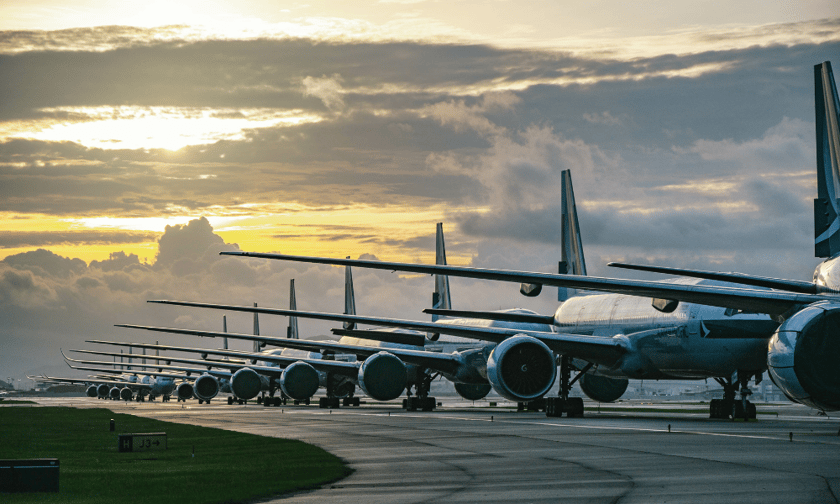

A spate of aviation incidents in recent months have renewed concerns about airline safety. Could the uptick in disasters impact airline insurance and reinsurance?
On November 24, 2024, the engine of a Russian plane caught fire after landing at Antalya airport in southern Turkey, prompting the evacuation of 95 people on board. On December 29, 2024, South Korea saw its deadliest air disaster after a Jeju Air plane crashed and killed nearly all of its 181 passengers and crew.
The new year also brought a fresh series of disasters. On January 29, an American Airlines flight collided mid-air withah a US Army Black Hawk helicopter over the Potomac River near Ronald Reagan Washington National Airport, causing 67 deaths. On February 17, a Delta Connection flight crashed at Toronto Pearson International Airport, dramatically flipping over upon landing.
“Aviation incidents often make front-page news and look quite frightening, regardless of scale,” said John Wadhams (pictured on the right), managing director, global aviation and space at WTW. “Senior management direction may be a key driver of market change.”
Charles Hollingworth (pictured on the left), executive director, global aviation and space at WTW, agreed.
"Often, perception competes with reality in times like this,” he said. “Any claim involving loss of life makes front-page news and draws intense scrutiny from senior management, who may not be deeply familiar with a particular portfolio.”
However, Hollingworth noted that the aviation industry has an enduring safety record, and the market has generally been able to perform profitably in recent years despite these incidents.
“Until that dynamic shifts, strong results will continue to override perception following recent incidents,” he added.
While major loss events still play a critical role in shaping market conditions, multiple factors will influence the sector in 2025, according to WTW’s airline insurance market renewal outlook for Q1 2025.
The airline insurance market has remained in a stable holding pattern for the past few years, defying expectations of a hardening environment. But while insurance supply remains abundant, shifting dynamics, including ongoing geopolitical disputes and rising claim costs, suggest that changes could be on the horizon.
According to WTW, the January 1 reinsurance renewals, a key indicator for the broader aviation insurance market, suggest that direct insurers remain open to negotiation. The strong performance of aviation reinsurers in recent years has allowed them to maintain balanced portfolios with sufficient margin to cover capital costs.
Some insurers took advantage of this stability by renewing their reinsurance treaties earlier than usual in late 2024, locking in favorable terms before potential market shifts.
Hollingworth said: “Excess of loss capacity remains available, partly due to program structures with reasonable retentions, giving reinsurers confidence in their margins. Quota share insurance, however, is more challenging as it attaches at the first dollar rather than excess levels. If quota share capacity dries up, it could reduce overall market capacity.”
One of the most pressing challenges for aviation insurers is the rising cost of smaller, attritional claims. These claims, which are typically absorbed before an insurer’s reinsurance program activates, are gradually eroding margins.
Attritional claims are estimated to represent between 50% and 66% of total annual premiums. Experts suggest that if the trend continues, insurers may find themselves with diminished resources to cover major loss events, ultimately leading to pricing adjustments or stricter underwriting standards.
At the same time, insurers are closely monitoring the potential resolution of ongoing litigation related to aircraft leasing disputes stemming from the Russia-Ukraine conflict. If reinsurers are ultimately required to absorb these claims, there could be a substantial reduction in available capacity, which would likely lead to increased rates and stricter underwriting terms.
Some reinsurance renewals scheduled for Q2 2025 coincide with expected court case resolutions, making that period a critical juncture for the aviation insurance market. If reinsurers withdraw capacity in response to adverse rulings, direct insurers may face reduced options, and buyers could see higher costs and stricter policy terms.
Wadhams, however, believes that the market has already adjusted to the event and that the outcome of the resolution likely won’t drive further changes. “One could argue that insurance pricing has already adjusted,” he said.
Hollingworth also doesn’t expect a “knee-jerk” market reaction. He explained: "The circumstances of the event, and the fact that we're discussing a possible resolution years after the proximate cause, mean the market has already adjusted through various cycles.
“A formal resolution will inevitably impact insurers' balance sheets and may influence underwriting, but enough time has passed for this to be managed. I don’t expect a knee-jerk market reaction.”
Wadhams also pointed out that the settlements are being made and shrouded in non-disclosure agreements, making it difficult for insurers to justify price increases. “Brokers naturally ask why and request a loss table, which insurers can’t always provide,” he said.
The WTW specialists encouraged insurance buyers to engage proactively ahead of renewal and seek advice from their broker about the mitigation strategies that could come into play if market conditions become more constrained.
Over the long term, winds are blowing favourably for the airline insurance industry, according to Hollingworth.
"The airline industry is set to grow, despite frustrations over aircraft delivery delays and supply chain challenges. This growth will significantly increase exposure for the airline insurance market over the next five to 10 years,” he said.
What are your predictions for the airline insurance market in 2025? Please share your views in the comments.
